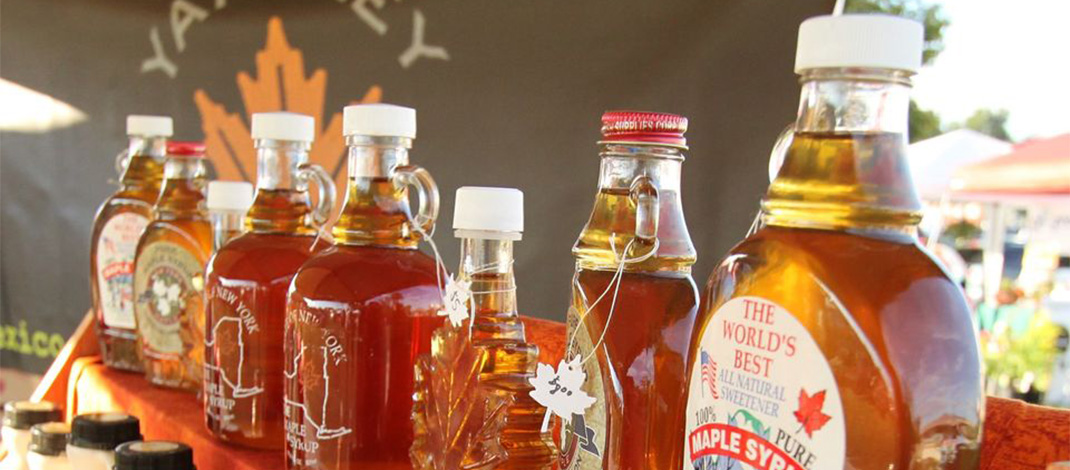Farm on target to make 1,500 gallons of maple this year
By Stefan Yablonski

Joe Yardley operates Yardley Maple on county Route 64 in New Haven, continuing a decades old family tradition.
“The best time for tapping trees, depends on the weather, I guess. We typically tap at the end of January,” Yardley said. “You need the freezing nights and the thawing days. If we get a bunch of those in January and February, we’ll get some sap, if not…”
They can tap early. They use a tubing system; a closed system where a vacuum is always pulling the sap away from the tree, he explained.
“Since it is just me and sometimes my dad helping — it takes a while to tap 4,100 trees. We have to start out early so we don’t miss out on the good run,” he said.
They tap hard and soft maples, sugar maples and red maples. You can tap any kind of maple, he said. The sugar maples typically have the higher sugar content. Sometimes the soft maples actually give you more sap.
The sap comes out if the tree as a solution — 98% water and 2% sugar. On average it takes around 45 gallons of sap to produce a gallon of syrup.
“That’s what they say; at 2% sugar content it takes about 45, 50 gallons,” Yardley said. “Our trees have a pretty low sugar content, so it usually takes 50 or 60 gallons.”
Third generation
His dad and grandfather did it on a much smaller scale. “They never used the vacuum or reverse osmosis or any of that,” he said.
A couple of years ago, Yardley bought a monitoring system.
“We have an antenna at the sugar house and we have a bunch of transmitters throughout the woods at each of our main lines they all talk to each other,” he explained. “Each transmitter bounces a signal to the next one and the next one and so on down to the sugar house. I can check the vacuum on every part of the main line on a computer in the sugar house and also on my phone. If there’s a leak somewhere, I’ll know it immediately and roughly where it is. I know at least what main line has the leak on it.”
The vacuum helps you get a lot more sap. For each inch of vacuum that you create, you get between 5% and 7% more yield. Every time the vacuum drops there is a little bit of a leak somewhere that we want to find as quick as we can. It affects the whole system if there is a squirrel chew or if a branch falls, he explained.
Typically, at the beginning of the season is when you make your highest quality syrup — the lighter syrup.
As the season goes on the days get warmer, the bacterium goes in; bacteria are part of what makes darker syrup. Also, how long it sits on the pan, the heat of the pan is what causes it to caramelize – start changing the color.
“We should be making 1,500 gallons a year. We added some more taps last year, about 500 more. We have been averaging 1,200 to 1,300 a year. But we should be making 1,500 now,” he said.
On March 7, they surpassed their total from last year of 1,133 gallons.
Yardley makes syrup, maple cotton candy, maple cream, maple sugar and maple candy.
“We do special events and make maple-covered almonds, peanuts and popcorn as well. We’ll have those for the Maple Weekend event (the last two weekends in March),” he said.
They have air injectors in the evaporators — tubes across the bottom of the pan that inject air into the evaporator while it is boiling and that helps to make lighter syrup. It just kind of lowers the temperature a little and helps make lighter syrup, Yardley explained.
“We concentrate it higher with the reverse osmosis machines. We run it through the R O machine and bring it up to somewhere around 22% sugar. So now it only takes us about four gallons of sap to make a gallon of syrup,” he said. “We remove a tremendous amount of water from it before it goes to the evaporator and hit the pans. Less time on the heat, less time to caramelize, means we can make lighter syrup.”
Their biggest customer is a maple candy maker in New Hampshire, who needs white syrup.
“So we try to make syrup as light as possible. The more we make, the more he buys,” Yardley said. “You can make light syrup darker, but you can never make dark syrup lighter.”
Taste varies
Maple syrup is maple syrup — sort of. The sap comes from the soil and it freezes at night and pushes moisture up into the tree. It thaws during the day and falls back down.
“So the syrup flavor will actually change from farm to farm. You can go down the road and taste syrup that might have a little bit different flavor than mine, depending on the soil type, what’s in the soil,” Yardley explained. “Syrup can taste quite different depending on where you go. Even my syrup will change from year to year and even day to day. Like I said as the season goes on you typically make darker and darker syrup —a more robust maple flavor the darker it gets.”
At least 30 miles of tubing
“I’ve been plucking away at it for years; 2012 was when we started putting the tubing out and we’ve added a little bit more every year since. The first year we set up tubing for around 1,200 trees. Now we are at more than 4,100. We just keep slowly adding over the years. We keep it up all year round; replace it as it needs it, as it wears out.
The squirrels, the porcupines, the deer, coyotes — they all gnaw on it every once in a while. But they usually get around it pretty good. You go out there and startle a deer, you can see them jumping over it and ducking under it. They run through it pretty quick.”
Some Area Maple Syrup Producers
• Maple Help Stock Farm, 207 Hurlbut Road, Mexico, 315-963-7558
• Maple Hollow Farm, 1309 County Route 85, Hannibal, 315-564-7133
• Pondview Lodge, 323 Stone Hill Road, Williamstown, 315-430-2004
• Red Schoolhouse Maple, 2437 County Route 4, Fulton, 315-243-1024
• Willow Creek Farm Maple Syrup, 390 Lakeshore Road, Fulton, 315-591-2308




